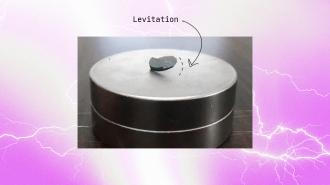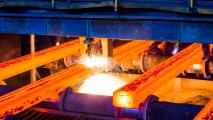South Korean researchers created a sensation last week with the claim that they have created one of the holy grails of physics: a room-temperature superconductor. Here’s what that would mean — and why many scientists aren’t celebrating, yet.
The challenge: When an electric current travels along a wire, some of its electrons will collide with particles in the material. This is called “resistance,” and it causes some of the energy to be lost, turned into heat, before it reaches its destination.
Different materials have different resistance, so, to avoid losing energy, we use materials with low resistance (and, thus, high conductivity), such as copper wires, to transport electricity.
Because these materials still lose some energy on the way, though, we have to generate more electricity than is actually consumed. This results in higher electric costs for consumers and, if the electricity is generated by fossil fuels, extra carbon emissions.
Superconductors 101: Superconductors are materials with no electrical resistance, and not only do they have the potential to make the electric grid more efficient, they could have a transformative impact on the entire world — but there’s a catch.
“A real, working room-temperature superconductor … would be one of the holy grails of modern physics.”
Mohammad Yazdani-Asrami
While researchers have identified superconducting materials, they only display that property at ultra-cold temperatures and, usually, ultra-high pressures. They’ve yet to find one that demonstrates superconductivity at room temperature and sea level pressure, and that’s what we need to revolutionize the power grid and for countless other practical applications, including fusion power, ultra-fast internet, and maglev trains.
“A real, working room-temperature superconductor which works at ambient pressure would be one of the holy grails of modern physics, unlocking major new developments in energy, transportation, healthcare, and communications,” said Mohammad Yazdani-Asrami of the University of Glasgow’s James Watt School of Engineering.
What’s new? On July 22, South Korean researchers shared two papers on the preprint server arXiv claiming that a material called LK-99 is an ambient pressure, room-temperature superconductor.
A few days later, one of the authors shared a video reportedly showing a bit of LK-99 levitating above a magnet, claiming it demonstrates the “Meissner effect,” a phenomenon in which materials expel all of their magnetic fields when transitioning into a superconducting state.
The response: At least one of the papers is reportedly being prepared for submission to a peer-reviewed journal — once that happens, journal editors and expert peer reviewers will scrutinize the paper to determine its scientific quality (and could potentially ask for more data).
In the meantime, independent researchers have been taking advantage of the fact that LK-99 is made from just four fairly accessible ingredients to try to synthesize the material and test its superconductive powers for themselves — with mixed results, so far.
Computer simulations suggest that LK-99 could, in theory, really be a room-temperature superconductor.
A team from the National Physical Laboratory of India wrote in a preprint paper that it found no evidence of room-temperature superconductivity in the material. Researchers at Beihang University in China reported the same results, adding that the material didn’t levitate for them.
Two students at Huazhong University shared a video of what they say is a flake of LK-99 levitating. There’s no way to verify this claim, currently, and even if it’s true, levitation alone does not prove it is a room-temperature superconductor — there are other properties that could achieve this effect, so the material also needs to demonstrate zero electrical resistance at room temperature.
Meanwhile, rather than actually making LK-99, a researcher at Lawrence Berkeley National Lab and a team from Shenyang National Laboratory for Materials Science each simulated the material using software — according to the two papers they shared on arXiv, it could work, in theory.
Skepticism abounds: Other teams have reported the creation of room-temperature superconductors before (usually combined with very high pressures), but none of them have stood up to the scrutiny of the scientific community.
“I will believe it if or when I see verification.”
Jens Koch
In response to the latest developments, the Korean Society of Superconductivity and Cryogenics has established a verification committee for room-temperature superconductors and asked for samples of LK-99 to analyze — but some scientists are fairly sure they already know what the committee will find.
“I take [the announcement of the room-temperature superconductor] with the proverbial grain of salt, though this particular grain seems closer to the size of a rock,” Jens Koch, a professor of physics at Northwestern University, told the Daily Beast.
“Some of my colleagues have already voiced concerns about the data presented by the South Korean group,” he added. “I will believe it if or when I see verification.”
Looking ahead: Several groups — including teams from Argonne National Laboratory, Seoul National University, and the University of Southern California, as well as private individuals with access to the right materials — are still trying to replicate the results of the South Korean team’s research.
It may take a little more time, but eventually, researchers will arrive at some sort of consensus as to whether LK-99 really is a room-temperature superconductor — and if it isn’t, the hunt for this kind of breakthrough will surely continue.
We’d love to hear from you! If you have a comment about this article or if you have a tip for a future Freethink story, please email us at [email protected].






